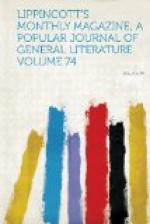[Illustration: Cork exhibition building, 1853.]
The first of the great fairs, in so many respects a model to all that came after, was beset at the outset by the same difficulty in arrangement encountered by them. How to reconcile the two headings of subjects and nations, groups of objects and groups of exhibitors, the endowments and progress of different races and the advance of mankind generally in the various fields of effort, was, and is, a problem only approximately to be solved. It was yet more complicated in 1851 from the compression of the entire display into one building of simple and symmetrical form, instead of dispersing certain classes of objects, bulky and requiring special appliances for their proper display, into subsidiary structures—the plan so effectively employed in Fairmount Park. A sort of compromise was arrived at which rendered possible the mapping of both countries and subjects, especially in the reports, and to some extent in the exhibition itself, without making the spectacle one of confusion. The visitor was enabled to accomplish his double voyage through the depths of the sea of glass without a great deal of backing and filling, and to find his log, after it was over, reasonably coherent.
The articles displayed were ranged under thirty heads. The preponderance of matter of fact was shown in the concession of four of these to raw material, nineteen to manufactures, and one to the fine arts. Twenty-nine atoms of earth to one of heaven! Of course the one-thirtieth whereinto the multiform and elastic shape of genius was invited, like the afreet into his chest, to condense itself, had to be subdivided—an intaglio and a temple, a scarabaeus and a French battle-picture, being very different things. This was accomplished, and the Muses made as comfortable as could be expected. They soon asserted the pre-eminence theirs by right




